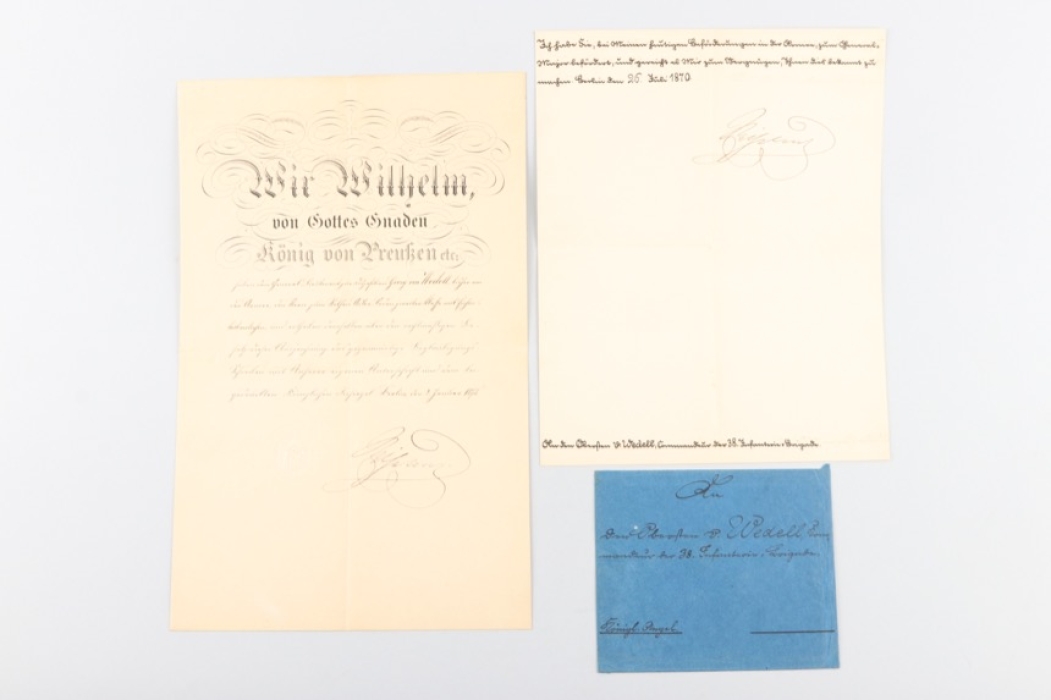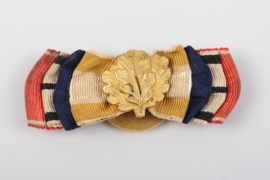Kreuz 2. Klasse mit Eichenlaub
Jetzt Lose für verringertes Aufgeld sichern

Preussen - Roter Adler Orden Kreuz 2. Klasse mit Eichenlaub
MILITARIA PREISDATENBANK
Wie kann ich Verkaufspreise sehen?
Melden Sie sich noch heute unter www.ratisbons.com/de/militaria-preisdatenbank für unsere MILITARIA PREISDATENBANK an! Bei Abschluss eines jährlichen Abonnements für nur 75€ sparen Sie 25%.
Ihr Zugang zu allen Verkaufspreisen, Bildern und Beschreibungen wird umgehend nach Abschluss Ihres Abonnements freigeschaltet.
We are buying single items and entire collections! Call +49 8541 9053699
-
Bezahlung
-
WIE KANN ICH FÜR MEINE BESTELLUNG BEZAHLEN?
AUKTIONAlle erfolgreichen Gebote werden automatisch zu einer einzigen Bestellung zusammengefasst. Für diese können Sie uns nach Auktionsende in Ihrem persönlichen Kundenkonto Ihre bevorzugte Bezahl- und Versandart oder eine alternative Lieferadresse mitteilen.
Wenn wir diese freiwilligen Angaben nicht von Ihnen erhalten melden wir uns automatisch im Laufe des Montags nach Auktionsende mit einer Zahlungsanweisung per Email. Basierend auf Erfahrungswerten schlagen wir Ihnen die bequemste Bezahlmehtode und die günstigste Versandart vor. Sie möchten Ihre Bezahl- und Versandart ändern oder eine alternative Lieferadresse angeben? Kein Problem! Besuchen Sie Kundenkonto/BESTELLUNGEN oder kontaktieren Sie uns per Email.
BESTELLUNGEN IM ONLINESHOPWählen Sie während der Bestellung Ihre bevorzugte Bezahl- und Versandart und schicken Sie diese ab. Sie erhalten Ihre Zahlungsanweisung spätestens am darauffolgenden Tag per Email. Die Zahlungsfrist beträgt sieben Tage. Sie planen eine Bestellung per Ratenzahlung zu begleichen? Bitte sprechen Sie uns gerne vor Ihrer Bestellung darauf an.
Für mehr Informationen zu Bezahlung und Versand, besuchen Sie unsere Häufigen Fragen.
WIR AKZEPTIEREN FOLGENDE BEZAHLARTEN
-
-
Versand
-
IHRE BESTELLUNG IN DEN BESTEN HÄNDEN
VERPACKUNG & SENDUNGSVERFOLGUNGNach Zahlungseingang versenden wir Ihre Bestellung für gewöhnlich am darauffolgenden Werktag. Wir bestätigen den Eingang Ihrer Zahlung per Email und informieren Sie zur Versandvorbereitung. Nach Abholung der Sendung durch unsere Versanddienstleister teilen wir Ihnen die Sendungsnummer per Email mit. Den Status Ihrer Sendung können Sie auch jederzeit unter Kundenkonto/BESTELLUNGEN einsehen. Ihre Rechnung geht Ihnen automatisch am Tag des Versands zu.
VERSAND ZU EINER ALTERNATIVEN ADRESSEBevorzugen Sie für eine Bestellung einen Versand zu Ihrer Arbeitsstelle? Sie sind im Urlaub und wünschen den Versand zu einer Packstation oder einem Freund? Kein Problem! Diese Änderungen können Sie jederzeit unter Kundenkonto/BESTELLUNGEN vornehmen. Alternativ können Sie natürlich jederzeit auch per Email informieren.
UNSERE PARTNER FÜR DEN VERSAND
-
-
Garantie
-
 GARANTIE!
GARANTIE!Alle angebotenen Artikel werden von unseren Experten akribisch auf deren Echtheit geprüft und detailiert beschrieben. Wir bieten ausschließen zeitgenössiche Originale an. Etwa 15% aller Kundeneinlieferungen ensprechen unseren Anforderungen nicht und werden retourniert.
Gekauft wie gesehen? Nicht bei uns. Im Gegensatz zu traditionellen Auktionshäusern bieten wir volles Rückgaberecht of Originalität an. Sollten Sie mit Ihrer Bestellung nicht zufrieden sein, können Sie die Bestellung innerhalb 14 Tagen widerrufen. Bitte kontaktieren Sie uns vor dem Rückversand. Für mehr Einzelheiten besuchen Sie bitte unsere häufigen Fragen.
In eigener Sache: Bieten Sie nur auf Lose, die Sie auch erwerben möchten. Bitte vermeiden Sie Gebote nach Auktionende zu stornieren. Sollten Sie ein fehlerhaftes Gebot abgegeben haben, informieren Sie uns bitte umgehend. Wir löschen Ihre Gebote gerne bis 24 Stunden vor Ende der Auktion.
-
Land Deutsches Kaiserreich
Maße
Gewicht
 US Los US1-496
US Los US1-496EAN 3000000003244
 US Los US1-496
US Los US1-496Epoche bis 1918
Land Deutsches Kaiserreich
Land Deutsches Kaiserreich
 US Los US1-496
US Los US1-496Deutsches Kaiserreich
Kreuz 2. Klasse mit Eichenlaub
Beschreibung
Two documents to General Georg von Wedell. He received the two classes of the Iron Cross and the Oak Leaves for the Order Pour le Mérite, for the successful defense of Beaune-la-Rolande
- an award document on the Prussian Red Eagle Order 2nd Class with Oak Leaf, awarded on January 2, 1875. Original ink signature from Wilhelm.
- Promotion document in form of a so called “Kabinetts Ordre” (informal order) to Oberst von Wedell from July 26, 1870. Promotion to General-Major. Original ink signature from Wilhelm. With fitting blue postal envelope with wax seal.
Georg was the son of the Prussian officer Wilhelm Sigismund von Wedell (1772–1827) and his wife Friederike Wilhelmine Christiane, née von Gregorski (1780–1851). His father was a captain a. D. and was last in the 3rd Battalion of the 9th Landwehr Regiment.
Wedell visited the cadet houses in Kulm and Berlin . He then joined the Guard Artillery Brigade of the Prussian Army on August 5, 1837 as a Second Lieutenant . From October 1, 1837 to July 15, 1839 he was assigned to the United Artillery and Engineering School. For further training followed from October 1, 1843 to July 15, 1846 as Prime Lieutenant (from October 10, 1842) the command to the General War School . During the Baden campaign , Wedell and the 7th Artillery Brigade took part in the siege and capture of Rastattpart. In 1850 he was assigned to the topographical department of the Great General Staff . At the same time as he was promoted to captain, he transferred to the 6th Artillery Regiment on July 22, 1852 , where he served as the battery chief from May 1, 1855 . From here Wedell was transferred to the General Staff on January 13, 1858 and promoted to major on July 12, 1858 . At the same time he was from October 1, 1859 to July 1, 1960 teacher of war history at the General War School. He was then transferred to the General Staff of the 16th Division . After his promotion to lieutenant colonelon March 17, 1863, on August 12, 1863, he was appointed commander of the 1st Battalion of Infantry Regiment No. 26
Two years later, from June 13, 1865, he was commander of Infantry Regiment No. 17 and promoted to colonel in this position . After only ten months, on April 3, 1866, he was transferred to the War Ministry , where he worked as a department head. When the German War broke out in June 1866, he became the commander of Infantry Regiment No. 31. He took command of the campaign in Bohemia, his regiment belonged to the 7th Division under General von Fransecky . The most important mission in this war was in the battle of Königgrätz: The 7th Division stopped the attack of two Austrian army corps in the battle for the Swiepwald. The battle for the Swiepwald was one of the key points in the battle. In this battle the regiment lost ten officers and 208 soldiers. For services in battle, Wedell received the order Pour le Mérite on September 20, 1866 .
With the mobilization in July 1870 on the occasion of the war against France , Wedell was given command of the 38th Infantry Brigade ( Regiments No. 16 and No. 57 ), which was part of the 19th Division ( Schwartzkoppen ) in the X Army Corps ( Voigts-Rhetz ). The first combat mission was in the battle of Mars-la-Tour on August 16, 1870. The fight began as an attack by the German III. Army corps against French troops moving from Metz towards Verdundeducted. What was planned as an attack against the rearguard of the French turns out to be a battle with the head of five entire army corps. Less than 30,000 German soldiers faced almost 130,000 French here. Wedell was on the way to the Maas with his brigade to intercept the French Rhine Army , which was supposed to be withdrawing , but was then sent to Mars-la-Tour as reinforcement. He arrived there around 4 p.m. after a day's march of almost 12 hours. Wedell received the order to attack the flank of the French army. Since there was no reconnaissance and the hilly terrain did not allow a good overview, this attack did not lead to the flank, but to the center of the IV French Corps ( Ladmirault). His two regiments came into the crossfire of two French divisions ( Grenier and Cissey ) when attacking the heights of Bruville .
Within less than 30 minutes, his regiments suffered the loss of 73 officers and 2543 men, including over 400 prisoners, and had to withdraw completely defeated. The two regimental commanders were among the dead. The soldiers had not even made it here to get the French troops in firing range of their guns. One cavalry attack onlyIt was thanks to the Guard Dragoons for relief that the regiments were not completely wiped out, but were able to break away from the enemy. A French counterattack was carried out with only one brigade and could therefore be repulsed when the French came within range of the German rifles. Wedell himself was wounded and his horse had been shot from under him.
After the battle, Wedell remained in reserve with the rest of his brigade at the Battle of Gravelotte and then stayed until the end of October 1870 as part of the Siege of Metz . Here he took part in the battle of Noisseville . After the fall of Metz on October 27, 1870 Wedell went with the 2nd Army under Friedrich Karl Nikolaus von Prussia to the area south of Paris on the Loire . Here the new French government had the Loire Armyset up. This army was numerically far superior to the German troops, but consisted to a large extent of volunteers and reservists, a few soldiers and dispersed. In order to intercept this army and thus secure the siege of Paris , the German troops marched in forced marches of around 25 km per day towards the Loire.
On November 28, 1870, the battle of Beaune-la-Rolande took place here . Two French corps with a total of 60,000 soldiers attacked three German brigades one after the other. The 38th Brigade under Wedell was supposed to hold Beaune-la-Rolande. At this point in time there were only 13 companies with a total of around 1200 men. During the fighting, the men of the 57th Infantry Regiment even set fire to the makeshift barricades to repel the attack. During the battle, the German soldiers used up almost all of their ammunition by early afternoon and were only saved by reinforcements from the 5th Division . At Mars-la-Tour Wedell was the 5th Division under Stülpnagelcame to the rescue, at Beaune-la-Rolande it was the other way around. The battle had thrown back the right wing of the Loire Army. For the successful defense of Beaune-la-Rolande, Wedell received the two classes of the Iron Cross and the Oak Leaves for the Order Pour le Mérite.
He took part in the Battle of Orléans in December 1870 , but fell ill in January 1871, so that he could not lead his troops in the Battle of Le Mans .
After the armistice, Wedell was still part of the occupation force in France. In November 1873 he then took over the 4th Division in Bromberg . In this role, he was promoted to lieutenant general in December 1873. On April 4, 1874 Wedell retired from active service, he was transferred to the officers of the army and to be on January 2, 1875 resignation out under award of the star to the Red Eagle . II Class with oak leaves with board for disposition made.
In 1879 he was accepted into the Frankfurt Freemason Lodge "Socrates for steadfastness". He later took up residence in Leer (Ostfriesland), where he died on March 27, 1894.
Zustand
1-
Verkäufer
History Trader Inc., 521 Thorn Street #165, Sewickly, PA 15143-0165, USA



